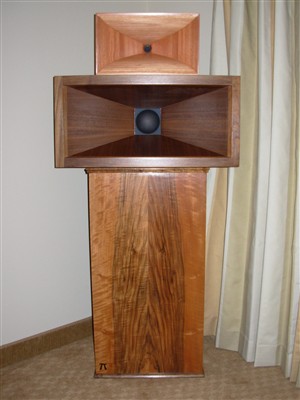| Two for one [message #53220] |
Tue, 17 February 2009 00:24  |
 Zene Gillette
Zene Gillette
Messages: 88
Registered: May 2009
|
Viscount |
|
|
Wayne ... in positioning my PI 7 wanabee horns as you suggest; i.e. aimed at a point just ahead of the seated position, I discovered that with the rotating horn lazysusan system for the UB and mids I find that the correct distance is probably somewhere between minimum at the equilateral seated position and several feet behind that.
Should I maintain the same focal point distance at each test position? All I remember you saying was just ahead but did not specify an actual distance or speaker offset angle. To do several angles at each seated position would put the tests in the +hundreds. I would like at least one constant in the test and ASSumed that to be the focal point.
Two ... I don't seem to be able to change speakers (only add) in CARA. I know I should have saved bare room (complicated), but did not. CARA is slow to answer. Thanks again, Zene
|
|
|
|
| seven π setup [message #53222 is a reply to message #53220] |
Tue, 17 February 2009 12:26   |
 |
 Wayne Parham
Wayne Parham
Messages: 18982
Registered: January 2001
|
Illuminati (33rd Degree) |
|
|
I suggest having the midhorn and tweeter angled inward 45°, same as the bass bin. The crossover is actually designed for that placement, with each horn mouth flush. It should look like this:
 seven π cornerhorn
seven π cornerhorn
Using this configuration does three useful things:
1. Early reflections are reduced because the horns' patterns radiate within the wall angle. Since each horn has 90° coverage, orienting them so their forward axis is at 45° prevents the sound from reflecting off either adjacent wall. The walls actually act more like flare extensions.
2. Each horn provides constant directivity, and the walls themselves provide pattern control for the lowest frequencies, all the way down to the Schroeder frequency. This provides constant directivity for nearly the entire audio spectrum. The only region that is not CD is the room's modal region, and that can be made uniform using a multi-sub setup, if desired.
3. The orientation having the forward axis angled inward 45° improves imaging. It naturalizes stereo balance between the two speakers, even for listeners that are not directly in between them.
The speakers generate a pattern with constant directivity, so the forward axis is not critical for maintaining spectral balance. The thing with imaging is actually related to SPL balance between the stereo pair. Having them pointed so their forward axes cross in front of the listening position creates a situation where side-to-side movement causes the furthest speaker to be more on-axis and the closest speaker to be more off-axis. This naturalizes stereo balance between the two speakers, even for listeners that are not directly in between them. Spectral balance is maintained by the speakers' constant directivity and stereo balance is maintained by the orientation of their forward axes crossing in front of the listener.
|
|
|
|
|
|
|
|
|
|
|
|







